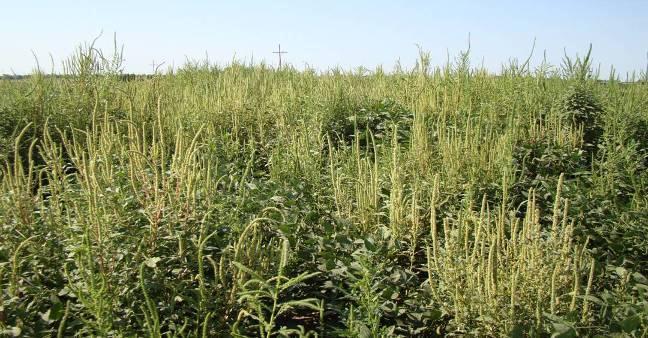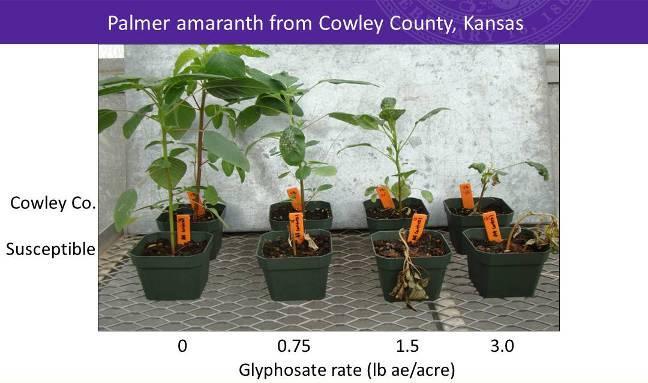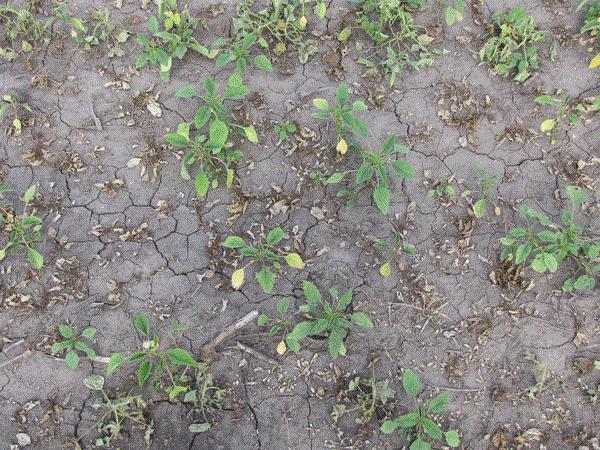To attempt to very this one way or another, waterhemp and Palmer amaranth seed were collected in the fall of 2011 from various soybean and cotton fields in eastern and south central Kansas. These fields had abundant pigweed escapes after being treated with glyphosate.
Palmer amaranth escapes in soyeans treated with glyphosate. Photos by Josh Putman, Graduate Research Assistant, Agronomy, K-State Research and Extension.
Waterhemp and Palmer amaranth plants from these different populations were grown in the greenhouse and treated with glyphosate at 0.75 (1X), 1.5 (2X), and 3 (4X) lb/acre to evaluate for resistance. Response of the different populations was compared to susceptible populations of both species collected from the Ashland Bottoms experiment field south of Manhattan, KS. The susceptible check populations of both species was completely controlled by all rates of glyphosate.

As expected, a number of the waterhemp populations from across eastern Kansas survived glyphosate treatment up to a 4X rate, and appeared to be resistant. Two populations of Palmer amaranth from Cowley county in south central Kansas also had a high percentage of plants that survived the 1X and 2X rates of glyphosate and had some plants that survived the 4X rate. These Palmer amaranth populations did not appear to be as resistant to glyphosate as some of the Palmer amaranth from the Southeast U.S., but weren't being controlled by typical field rates in the greenhouse or with multiple applications of glyphosate in the field. Thus, it appears that glyphosate-resistant Palmer amaranth may now be present in Kansas.

Palmer amaranth seed was collected from additional fields this past fall and is now being evaluated in the greenhouse. Preliminary observations suggest that we are seeing similar survival after glyphosate treatments from Palmer amaranth collected from fields south of Great Bend, along with additional populations collected south of Wichita. Research on inheritance and the mechanism of resistance will need to be conducted to further characterize and confirm glyphosate resistance in these populations. Confirming herbicide resistance is a long and detailed process.
Regardless of whether glyphosate-resistant Palmer amaranth is present in your area now, there is a good chance it will develop at some point based upon what has happened in the Southeast U.S., especially if growers rely heavily on glyphosate for weed control.
Palmer amaranth is an extremely competitive weed and the development of glyphosate resistance means it will require an effective integrated weed management program to achieve acceptable control. Continuing to rely only on glyphosate for weed control, will only speed up the development of glyphosate-resistant weeds and diminish its effectiveness. Utilizing residual herbicides with different modes of action throughout the cropping system will help to manage existing glyphosate-resistant weeds and slow the development of new glyphosate-resistant weed populations.
-Dallas Peterson, Weed Management Specialist
dpeterso@ksu.edu
-Josh Putnam, Graduate Research Assistant, Agronomy
jputman@ksu.edu
-Curtis Thompson, Extension Agronomy State Leader and Weed Management Specialist
cthompso@ksu.edu


